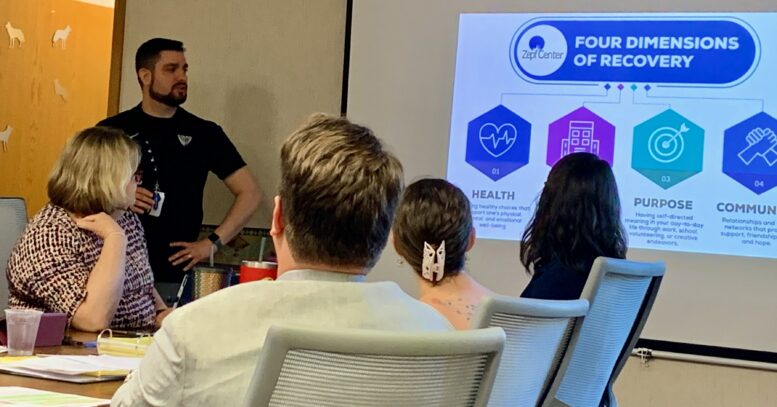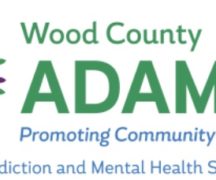By JULIE CARLE
BG Independent News
Wood County mental health and addiction services professionals will soon have a new tool to help strengthen motivation for change in individuals they are working with.
The Wood County Alcohol, Drug Addiction and Mental Health Services Board on Monday approved a contract with Great Lakes Training Inc., a Michigan-based company, to train local professionals in the evidence-based method of counseling.
Motivational Interviewing is described as a collaborative, goal-oriented style of communication to facilitate change.
Basic training will be provided to 30 community members representing youth and adult services including law enforcement, probation officers, attorneys, correction staff, treatment providers and recovery support service staff. Advanced training will be provided to at least 20 of the participants who completed the basic training.
Twelve of the professionals who have completed basic and advanced training will participate in the Train the Trainer sessions. The trainer group will be expected to conduct two training courses each year, with a goal of training an additional 100 people in Motivational Interviewing annually in Wood County.
The contract with Great Lakes Training Inc. is for $32,525.73. The bulk of the contract will be covered by State Opioid and Stimulant Response funds and the balance will be covered by the county levy, said WCADAMHS Director of Finance Julie Launstein.
Allocation presentations for OhioGuidestone and Zepf Center
As part of the county board’s annual allocation process, Victoria Graham from OhioGuidestone and Brandon Smith from Zepf Center, updated the board about outcomes and new requests for the 2025 fiscal year.
OhioGuidestone provides services at 39 locations in 32 Ohio counties. In Wood County, the agency provides general mental health services that include assessment, counseling, relational skill building for parents, psychiatry and case management. For substance abuse services, they offer intensive all the way to non-intensive levels of care, peer support, medication-assisted treatment, residential treatment and recovery housing.
“We offer services in the home, the community; we have school-based services and office services, and now we do telehealth across the state,” said Graham, regional director for the Wood County office.
They provided more than 26,000 services to individuals in the county in 2023.
“Our specialized services are what set us apart,” Graham said.
The DoubleARC Center for Fetal Alcohol Spectrum Disorders is one of only three diagnostic sites in Ohio for anybody who has had an effect from somebody using alcohol during pregnancy. The disorder, which is severely underdiagnosed, can present in physical and behavioral means, she said.
The center provides diagnoses and counseling specific to each individual’s needs. The county board provides support for the consultation.
The criminal justice program is another specialized service that OhioGuidestone provides, Graham said. A screener position, which is half funded by the Wood County board and half by State Opioid and Response Stimulus funds, is based in the jail to work with clients where they are. The screener is the person they see in group therapy and who checks in on how they are doing.
A criminal justice liaison works with different systems and does diagnostic assessments. Because they work with a variety of agencies in the community they keep a lot of data and tracking information about helping individuals with re-entry into communities. The WCADAMHS Board funds 80% of the liaison position and the state funds the remaining 20%.
The agency’s Community Transitional Program uses pass-through funds from the state to help individuals get back into society, housing and work, Graham explained.
OhioGuidestone is seeking support for a new expressive arts program.
“The program combines traditional counseling with something creative such as painting, writing, dancing, singing or whatever why you want to express yourself,” she said. “Maybe they aren’t ready to talk. Maybe they are not very verbal, or they have cognitive delays that makes them not benefit from traditional counseling,” she said.
For people who can’t afford supplies, the program would be able to provide clay, paint, or other materials. “The program is so powerful, everyone on staff bought into the results,” she said.
“The clinical services (of OhioGuidestone) are doing exceptionally well in outcomes,” said Laura Fullenkamp, director of criminal justice and compliance. A couple of outcome areas have decreased, but staff are working on ideas for improvement.
The Zepf Center operates a nine-bed men’s recovery facility in Cygnet and outpatient services for Wood County residents, said Smith, senior residential director at the Zepf Center.
The facility uses four pillars of recovery: health, home, purpose and community for the residents.
Certified as a Level Three recovery house, the house has served 144 residents since it opened in 2016. The majority of the residents have come directly from jail or an inpatient treatment facility. The average rate of stay is 104 days and 82% are employed, in school or a volunteer role.
“Work provides a sense of community and purpose, and helps transition back into a functioning society,” he said
The program provides transportation for the residents to attend probation meetings, and peer support group meetings in other locations.
Because the residency rate has not met expectations, they are focusing on improving the numbers and are currently at seven of the nine beds in use.
“Our most recent success rate was 55%, which means they engaged in the program and transitioned to safe, stable places,” Smith said.
The board also supports the Zepf Center’s outpatient services for substance use disorders. They served 127 Wood County residents to date in the fiscal year.
“There are a lot of services we provide, but we are able to provide methadone. There’s a lack of methadone in the community for a lot of clients, so we are able to provide it for Wood County residents,” Smith said. An average of 19 individuals per quarter receive methadone with a majority of them reporting progress.
“We are able to offer certain levels of care that are not as easy to access in Wood County, including withdrawal management sub-acute detoxification and inpatient residential treatment,” he said.
They also offer group therapy, psychiatry and medication-assisted therapy.
Outcomes for fiscal year include 87% of people staying in treatment for a minimum of 90 days. “We know retention and continuing treatment is a big deal for positive recovery outcomes,” he said.
Currently, the average time from contact to assessment is 1.6 days, which means individuals are not on a waitlist for months. The length of time from assessment to start of service is a little over eight days, which Smith said they are working to reduce that time frame.
“Zepf is doiong a lot of great things,” said Fullenkamp, especially the outcome of keeping clients engaged and involved for over 90 days.
“They are on track to well exceed their fee for service number of clients they are seeing. They will see an increase in fee for service next year and a slight increase in SOS funding,” said WCADAMHS Executive Director Amanda Kern.





